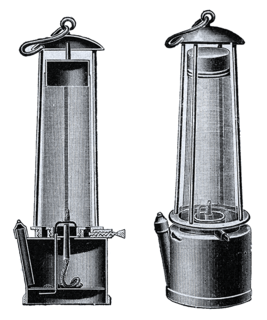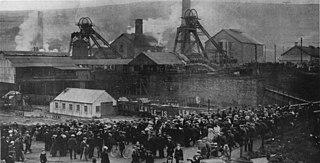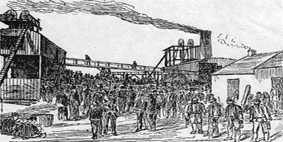
The Luisenthal mine disaster was the most serious mine accident in the history of the Federal Republic of Germany. The explosion killed 299 miners. [1]

The Luisenthal mine disaster was the most serious mine accident in the history of the Federal Republic of Germany. The explosion killed 299 miners. [1]
The Luisenthal Mine is located in Völklingen, a town in the state of Saarland, Germany. The mine has been in operation since the 1800s, although coal has been mined in Luisthenal since 1719. [2] The Luisenthal mine was considered to be very susceptible to firedamp explosions due to the high concentration of firedamp in the seams. From 1904 to 1954 there were 20 fires and explosions in the pit. In 1941, an explosion killed 41 miners. Because of this, the pit was equipped with state-of-the-art technology. Subsequently, the mine was awarded for its high safety standards. [3]
During the early shift on 7 February 1962, there were 664 miners working in the pit. Around 7:45 a.m., an explosion occurred in the Alsbach shaft of the mine at a depth of more than 600 meters, (more than 1,968 feet). [4] The explosion was strong enough to lift the manhole cover off the Alsbach shaft. [5] 299 miners were killed in the explosion, while 73 miners were injured. Some of those who died underground were burned beyond recognition.
The cause of the explosion is still unclear. Among other things, it was speculated whether a miner had smoked illegally underground, because cigarettes were found during the clean-up work. A defective mine lamp was also named as a possible cause. Today, it is believed that a coal dust explosion occurred as a result of a primary firedamp explosion. [6]

On February 11, 1962, a memorial was held for 286 of the dead miners. The memorial was led by the then West Germany President, Heinrich Luebke. Around 4,500 people were in attendance. [7]
The Luisenthal Mine closed down on June 17, 2005. Near the now abandoned pit there is a memorial with a statue of St. Barbara, the patron saint of miners. [8] A wall of 299 stones with continuous niches for placing memorial candles symbolizes the 299 victims of the accident. The monument was made by the artist Lothar Meßner (1926–2019). [9] There is also a memorial to the dead miners in the building of the Saarbrücken Mining Directorate. The memorial is a series of three stained glass windows, and is titled "Our Dead Miners". [10]

The Davy lamp is a safety lamp for use in flammable atmospheres, invented in 1815 by Sir Humphry Davy. It consists of a wick lamp with the flame enclosed inside a mesh screen. It was created for use in coal mines, to reduce the danger of explosions due to the presence of methane and other flammable gases, called firedamp or minedamp.
Coal dust is a fine powdered form of which is created by the crushing, grinding, or pulverizing of coal. Because of the brittle nature of coal, coal dust can be created during mining, transportation, or by mechanically handling coal. It is a form of fugitive dust.
Firedamp is any flammable gas found in coal mines, typically coalbed methane. It is particularly found in areas where the coal is bituminous. The gas accumulates in pockets in the coal and adjacent strata and when they are penetrated the release can trigger explosions. Historically, if such a pocket was highly pressurized, it was termed a "bag of foulness".
The Blantyre mining disaster, which happened on the morning of 22 October 1877, in Blantyre, Scotland, was Scotland's worst ever mining accident. Pits No. 2 and No. 3 of William Dixon's Blantyre Colliery were the site of an explosion which killed 207 miners, the youngest being a boy of 11. It was known that firedamp was present in the pit and it is likely that this was ignited by a naked flame. The accident left 92 widows and 250 fatherless children.

Easington Colliery is a town in County Durham, England, known for a history of coal mining. It is situated to the north of Horden, a short distance to the east of Easington Village. The town suffered a significant mining accident on 29 May 1951, when an explosion in the mine resulted in the deaths of 83 men.

The Luisenthal Mine was a coal mine near Völklingen. The mine was known as the site of the largest mine accident in the history of the German Federal Republic, when 299 miners died on 7 February 1962.
A safety lamp is any of several types of lamp that provides illumination in coal mines and is designed to operate in air that may contain coal dust or gases, both of which are potentially flammable or explosive. Until the development of effective electric lamps in the early 1900s, miners used flame lamps to provide illumination. Open flame lamps could ignite flammable gases which collected in mines, causing explosions; safety lamps were developed to enclose the flame and prevent it from igniting the surrounding atmosphere. Flame safety lamps have been replaced in mining with sealed explosion-proof electric lights.

The Senghenydd colliery disaster, also known as the Senghenydd explosion, occurred at the Universal Colliery in Senghenydd, near Caerphilly, Glamorgan, Wales, on 14 October 1913. The explosion, which killed 439 miners and a rescuer, is the worst mining accident in the United Kingdom. Universal Colliery, on the South Wales Coalfield, extracted steam coal, which was much in demand. Some of the region's coal seams contained high quantities of firedamp, a highly explosive gas consisting of methane and hydrogen.

The Oaks Colliery explosion was a British mining disaster which occurred on 12 December 1866, killing 361 miners and rescuers at the Oaks Colliery at Hoyle Mill near Stairfoot in Barnsley, West Riding of Yorkshire. The disaster centred upon a series of explosions caused by firedamp, which ripped through the underground workings. It is the worst mining accident in England and the second worst mining disaster in the United Kingdom, after the Senghenydd colliery disaster in Wales.
Clifton Hall Colliery was one of two coal mines in Clifton on the Manchester Coalfield, historically in Lancashire which was incorporated into the City of Salford in Greater Manchester, England in 1974. Clifton Hall was notorious for an explosion in 1885 which killed around 178 men and boys.

The Udston mining disaster occurred in Hamilton, Scotland on Saturday, 28 May 1887 when 73 miners died in a firedamp explosion at Udston Colliery. Caused, it is thought, by unauthorised shot firing the explosion is said to be Scotland's second worst coal mining disaster.
The Elsecar Collieries were the coal mines sunk in and around Elsecar, a small village to the south of Barnsley in what is now South Yorkshire, but was traditionally in the West Riding of Yorkshire.
The South Yorkshire Coalfield is so named from its position within Yorkshire. It covers most of South Yorkshire, West Yorkshire and a small part of North Yorkshire. The exposed coalfield outcrops in the Pennine foothills and dips under Permian rocks in the east. Its most famous coal seam is the Barnsley Bed. Coal has been mined from shallow seams and outcrops since medieval times and possibly earlier.

The Astley Deep Pit disaster was a mining accident at the Astley Deep Pit, in Dukinfield, Cheshire, England, that took place on 14 April 1874, killing 54 men and boys. Astley Deep Pit was a coal mine started around 1845 to work the seam of coal known as the "Lancashire Black Mine". When finished, it was supposedly the deepest coal-mine in Britain and cost £100,000 to sink.
The Minnie Pit disaster was a coal mining accident that took place on 12 January 1918 in Halmer End, Staffordshire, in which 155 men and boys died. The disaster, which was caused by an explosion due to firedamp, is the worst ever recorded in the North Staffordshire Coalfield. An official investigation never established what caused the ignition of flammable gases in the pit.
The West Stanley colliery was a coal mine near Stanley. The mine opened in 1832 and was closed in 1936. Over the years several seams were worked through four shafts: Kettledrum pit, Lamp pit, Mary pit and New pit. In 1882 an underground explosion killed 13 men and in 1909 another explosion killed 168 men.

The Lundhill Colliery explosion was a coal mining accident which took place on 19 February 1857 in Wombwell, Yorkshire, UK in which 189 men and boys aged between 10 and 59 died. It is one of the biggest industrial disasters in the country's history and it was caused by a firedamp explosion. It was the first disaster to appear on the front page of the Illustrated London News.

The Maypole Colliery disaster was a mining accident on 18 August 1908, when an underground explosion occurred at the Maypole Colliery, in Abram, near Wigan, then in the historic county of Lancashire, in North West England. The final death toll was 76.

The Mammoth Mine disaster or Frick Mine explosion occurred on January 27, 1891 just after 9:00 AM in the Mammoth No. 1 mine in Mount Pleasant Township, Westmoreland County, Pennsylvania. Newspapers reported that firedamp was ignited by a miner's oil lamp, resulting in the deaths of 109 men and boys. Most of the miners were not killed by the force of the explosion, but rather were suffocated by the effects of afterdamp.
Hapton Valley Colliery was a coal mine on the edge of Hapton near Burnley in Lancashire, England. Its first shafts were sunk in the early 1850s and it had a life of almost 130 years, surviving to be the last deep mine operating on the Burnley Coalfield.
{{cite web}}: |first= has generic name (help)